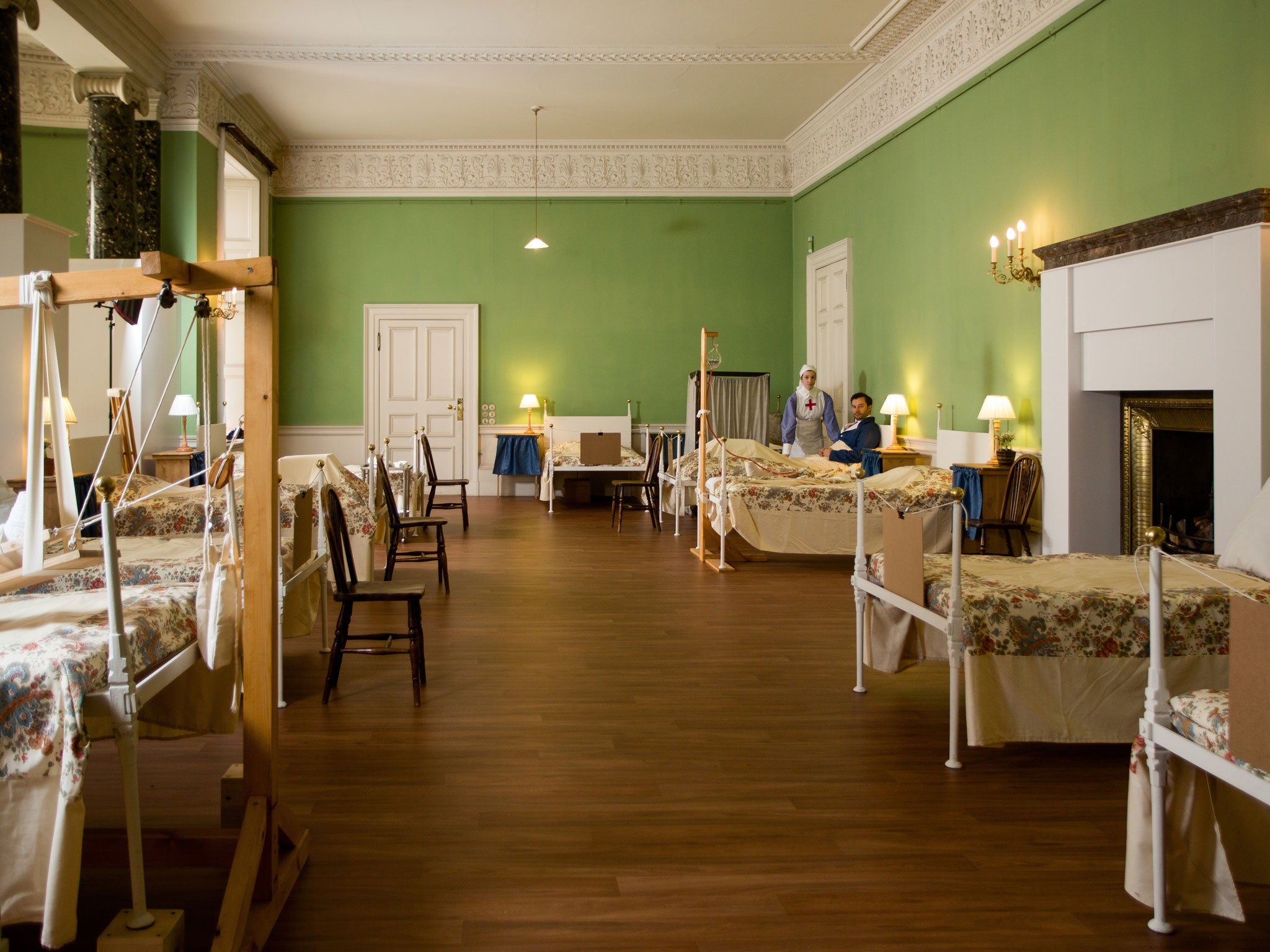The Independent's journalism is supported by our readers. When you purchase through links on our site, we may earn commission.
First World War Centenary: Dunham Massey Hall reconverted into a hospital
Dunham Massey Hall in Cheshire has been converted back into the hospital it, and many other large homes, were during the First World War

In 1914, when war broke out, there were 7,000 hospital beds in the UK, clearly nowhere near enough for the millions of soldiers returning from the front line seriously injured.
The solution presented itself in the form of thousands of homes, parks, schools and buildings up and down the country, which were requisitioned or volunteered for use as auxiliary military hospitals or convalescence homes.
Dunham Massey Hall, in Cheshire, was offered to the Red Cross in 1917 by its owner Lady Stamford, who worked as the hospital’s commandant. Her daughter, Lady Jane Grey, trained as a nurse and helped the hundreds of soldiers who stayed in the house, with ailments varying from gas poisoning to bullets in the brain. The day-to-day running of the hospital was Sister Catherine Bennett’s responsibility.
Now, 100 years later, Lady Jane’s personal scrapbook and Sister Bennett’s log, along with letters, artefacts and photographs have helped National Trust staff to transform the house back into Stamford Military Hospital and tell the soldiers’ stories as part of the centenary commemorations of the First World War.
Much as in the original transformation a century ago, columns have been boxed in and precious furniture and paintings removed. In their place, visitors can see the hospital’s main ward in the saloon, the recreation room, the operating theatre, and the nurses’ station.
“Each of the beds in the hospital’s main ward, known as Bagdad, represents a named soldier and illustrates his particular war injury,” says Katie Taylor, Dunham’s house and collections manager. “We are also providing re-enactments, involving actors playing the soldiers.”
One of the real soldiers to have been treated at Dunham Massey was Private William Johnstone, who arrived with two pieces of shrapnel in his brain. The doctor, assisted by Lady Jane, had to drill through his skull in the makeshift, operating theatre under the great stairs. “Surgery was performed there because it was next to the billiards room, which had a toilet. Sadly, they managed to remove the first bit of shrapnel, but he died at Manchester Royal Infirmary before they could remove the second piece.”
Another converted stately home where surgery was performed during the war was Highclere Castle in Hampshire, now famous as the shooting location of Downton Abbey. But most, such as Overbeck’s in Devon, were simply places where soldiers could recover and recuperate. “Of the 1,010 soldiers who passed through Overbeck’s, none died, but 15 got married to nurses or local girls,” says Ian Wren, a volunteer at the house. “The owners, Mr and Mrs Vereker, offered their house to the Red Cross in memory of their son who was killed in battle.”
Two autograph books belonging to Nurse Annie Yeoman at the site contain personal messages from the soldiers. “One is simply a desperate plea not to be sent back to the trenches,” says Mrs Yeoman’s son, Robert Chapman.
Aside from stately homes, many smaller private residences and warehouses were converted across London. These include a warehouse on Stamford Street in Waterloo where more than 70,000 military personnel were treated, including innovative plastic surgery cases. Tunnels were built connecting the hospital to Waterloo Station for the movement of supplies, but also to protect the wounded from the sight of the public.
Other locations were the Palace Green Hospital at 10 Palace Green, which was the first to treat shell-shocked army officers; the Swedish War Hospital, previously an asylum and Institute of Gymnastics; and a South African hospital in Richmond Park containing a concert hall. While in Jamaica Road, Bermondsey, the Princess Club hospital had a massage parlour, smoking room and a mortuary in the garden.
Most of the hospitals closed soon after the war ended. Now all that remains are Tesco’s, Costa Coffees, wedding venues and residential properties – oh, and the Post Office Home Hospital in Kensington Palace Gardens where the Sultan of Brunei now resides.
Subscribe to Independent Premium to bookmark this article
Want to bookmark your favourite articles and stories to read or reference later? Start your Independent Premium subscription today.

Join our commenting forum
Join thought-provoking conversations, follow other Independent readers and see their replies